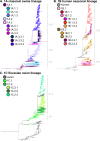A Phylogeny-Based Global Nomenclature System and Automated Annotation Tool for H1 Hemagglutinin Genes from Swine Influenza A Viruses
- PMID: 27981236
- PMCID: PMC5156671
- DOI: 10.1128/mSphere.00275-16
A Phylogeny-Based Global Nomenclature System and Automated Annotation Tool for H1 Hemagglutinin Genes from Swine Influenza A Viruses
Abstract
The H1 subtype of influenza A viruses (IAVs) has been circulating in swine since the 1918 human influenza pandemic. Over time, and aided by further introductions from nonswine hosts, swine H1 viruses have diversified into three genetic lineages. Due to limited global data, these H1 lineages were named based on colloquial context, leading to a proliferation of inconsistent regional naming conventions. In this study, we propose rigorous phylogenetic criteria to establish a globally consistent nomenclature of swine H1 virus hemagglutinin (HA) evolution. These criteria applied to a data set of 7,070 H1 HA sequences led to 28 distinct clades as the basis for the nomenclature. We developed and implemented a web-accessible annotation tool that can assign these biologically informative categories to new sequence data. The annotation tool assigned the combined data set of 7,070 H1 sequences to the correct clade more than 99% of the time. Our analyses indicated that 87% of the swine H1 viruses from 2010 to the present had HAs that belonged to 7 contemporary cocirculating clades. Our nomenclature and web-accessible classification tool provide an accurate method for researchers, diagnosticians, and health officials to assign clade designations to HA sequences. The tool can be updated readily to track evolving nomenclature as new clades emerge, ensuring continued relevance. A common global nomenclature facilitates comparisons of IAVs infecting humans and pigs, within and between regions, and can provide insight into the diversity of swine H1 influenza virus and its impact on vaccine strain selection, diagnostic reagents, and test performance, thereby simplifying communication of such data. IMPORTANCE A fundamental goal in the biological sciences is the definition of groups of organisms based on evolutionary history and the naming of those groups. For influenza A viruses (IAVs) in swine, understanding the hemagglutinin (HA) genetic lineage of a circulating strain aids in vaccine antigen selection and allows for inferences about vaccine efficacy. Previous reporting of H1 virus HA in swine relied on colloquial names, frequently with incriminating and stigmatizing geographic toponyms, making comparisons between studies challenging. To overcome this, we developed an adaptable nomenclature using measurable criteria for historical and contemporary evolutionary patterns of H1 global swine IAVs. We also developed a web-accessible tool that classifies viruses according to this nomenclature. This classification system will aid agricultural production and pandemic preparedness through the identification of important changes in swine IAVs and provides terminology enabling discussion of swine IAVs in a common context among animal and human health initiatives.
Keywords: H1N1; H1N2; influenza A virus; molecular epidemiology; nomenclature; swine; virus evolution.
Figures


References
-
- Van Reeth K, Nauwynck H, Pensaert M. 1996. Dual infections of feeder pigs with porcine reproductive and respiratory syndrome virus followed by porcine respiratory coronavirus or swine influenza virus: a clinical and virological study. Vet Microbiol 48:325–335. doi:10.1016/0378-1135(95)00145-X. - DOI - PMC - PubMed
-
- Garten RJ, Davis CT, Russell CA, Shu B, Lindstrom S, Balish A, Sessions WM, Xu X, Skepner E, Deyde V, Okomo-Adhiambo M, Gubareva L, Barnes J, Smith CB, Emery SL, Hillman MJ, Rivailler P, Smagala J, de Graaf M, Burke DF, Fouchier RAM, Pappas C, Alpuche-Aranda CM, López-Gatell H, Olivera H, López I, Myers CA, Faix D, Blair PJ, Yu C, Keene KM, Dotson PD, Boxrud D, Sambol AR, Abid SH, St George K, Bannerman T, Moore AL, Stringer DJ, Blevins P, Demmler-Harrison GJ, Ginsberg M, Kriner P, Waterman S, Smole S, Guevara HF, Belongia EA, Clark PA, Beatrice ST, Donis R, Katz J, Finelli L, Bridges CB, Shaw M, Jernigan DB, Uyeki TM, Smith DJ, Klimov AI, Cox NJ. 2009. Antigenic and genetic characteristics of swine-origin 2009 A(H1N1) influenza viruses circulating in humans. Science 325:197–201. doi:10.1126/science.1176225. - DOI - PMC - PubMed
Grants and funding
LinkOut - more resources
Full Text Sources
Other Literature Sources
